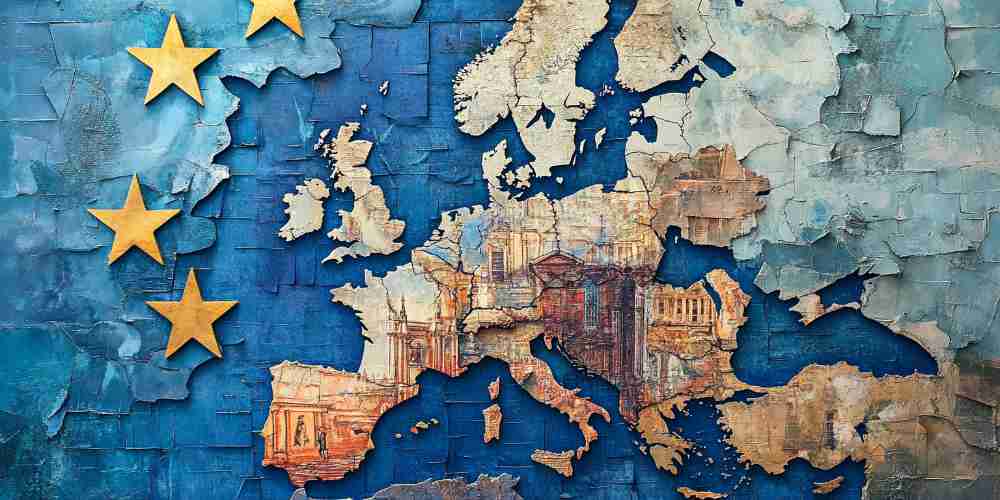The “United States of Europe”: An Unattainable Dream?

The idea of a “United States of Europe” is often put forward by European federalists who advocate for a stronger integration of the European Union. The comparison with the United States of America is frequently made, but is it justified? While the US has become a successful federal state, there are fundamental differences between Europe and America that make similar unification difficult. The historical, linguistic, cultural, and geopolitical reality of Europe makes the creation of a federal European superstate much more complex than is often suggested.
Historical Background: A Continent of Centuries-Long Rivalry
America: A Young Federation
The United States of America was founded in 1776 after the declaration of independence of the British colonies. Although the thirteen original states had their own identities and administrative structures, they were relatively young and united by a shared language, culture, and a common struggle against Great Britain (Wood, 2009). This ultimately led to the US Constitution in 1787, which established a strong federal government with clear powers.
Europe: Centuries of Conflict and National Identity
From the Hundred Years’ War between England and France to the Napoleonic Wars and the two World Wars of the 20th century, Europe has historically been a continent of rivalry and shifting alliances (Judt, 2005). This centuries-long struggle has led to deeply rooted national identities and a strong attachment to sovereignty. Even within the current European Union, national autonomy remains a sensitive issue, as evidenced by Brexit and the Eurosceptic movements in several countries (Zielonka, 2014).
Moreover, no attempt at a pan-European union—from the Holy Roman Empire to Napoleon’s European empire and the Soviet Union—has lasted in the long term. This points to the inherent difficulty of uniting Europe under one central authority.
Language Barriers: No Shared Native Language
English as a Unifier in the US
The United States of America has English as its common language, which contributes to strong national unity. Despite regional accents and dialects, English is the dominant language in politics, education, and media, making communication and governance easier (Huntington, 2004).
European Linguistic Diversity and Barriers to Integration
Europe, on the other hand, is a continent with dozens of different languages and dialects. Although English is often spoken as a second language, the native language remains the primary language of governance, education, and culture (Foucher, 2019). This linguistic difference complicates the formation of a European federation, as a shared language is crucial for national cohesion.
Furthermore, effective democratic decision-making requires a shared understanding of laws, policies, and political debates. In the EU, documents and legislation must be translated into 24 official languages, creating an enormous bureaucratic burden and complicating communication between citizens and institutions.
Cultural Diversity and National Identity
The American Melting Pot and Shared Values
The American identity is in many ways an immigrant culture, where new citizens integrate into a shared American ideal. While there are cultural differences between states like Texas and California, the national identity largely transcends these differences (Huntington, 2004). Through a shared historical myth of freedom and democracy, Americans feel more connected to their federal government than Europeans do to the EU.
European Cultural Fragmentation and Conflicts
Europe, by contrast, has deeply rooted cultural differences that span religion, traditions, and social structures. The norms and values in Scandinavia differ greatly from those in Southern Europe, and Eastern European countries like Poland and Hungary often pursue more conservative policies than Western European countries like the Netherlands and Germany (Rosato, 2011).
This cultural diversity makes it difficult to create a shared European identity. Initiatives like the European flag, anthem, and “European identity” have so far had little impact on citizens’ national loyalty.
Geopolitical Complexity: Russia and War on European Soil
Russia: Part of Europe, but Not of the EU
Another major obstacle to a “United States of Europe” is the geopolitical complexity of the continent. Russia is a European country, but it is in strong geopolitical competition with the EU (Foucher, 2019).
The War in Ukraine and European Instability
The current war in Ukraine shows that military conflicts between European states are still a reality. The idea of a united Europe is further complicated by the fact that not all countries share the same geopolitical interests (Zielonka, 2014). While some EU countries like Poland and the Baltic states take a hard line against Russia, other countries like Hungary and France are more hesitant in their confrontation with Moscow.
Economic Inequality and Governance Challenges
America’s Shared Currency and Tax System
The US states share a common currency, a federal tax system, and a centralized economic policy. This ensures financial stability and a level playing field between states.
The Eurozone: Fragmentation and Economic Tensions
In Europe, on the other hand, there is a significant difference between countries within the eurozone and those outside it. The economic inequality between wealthier countries like Germany and poorer EU member states like Bulgaria or Romania leads to tensions over the redistribution of resources (Judt, 2005). Moreover, not all EU countries use the euro, complicating monetary and fiscal cooperation.
Conclusion: A European Superstate is Unrealistic
While the idea of a “United States of Europe” may seem appealing to some, the historical, cultural, linguistic, economic, and geopolitical realities suggest that such a federation is not easy to achieve. Unlike the United States of America, Europe lacks a shared language, a unified national identity, a consistent economic policy, and a stable geopolitical climate.
Instead of a forced federal unification, a pragmatic collaboration between sovereign European states seems a more realistic path. The future of Europe is likely in a model where countries cooperate in specific areas, such as trade and security, without relinquishing their national identity and autonomy.
Referenties
- Foucher, M. (2019). L’obsession des frontières. Perrin.
- Huntington, S. P. (2004). Who Are We? The Challenges to America’s National Identity. Simon & Schuster.
- Judt, T. (2005). Postwar: A History of Europe Since 1945. Penguin Press.
- Rosato, S. (2011). Europe United: Power Politics and the Making of the European Community. Cornell University Press.
- Wood, G. S. (2009). Empire of Liberty: A History of the Early Republic, 1789-1815. Oxford University Press.
- Zielonka, J. (2014). Is the EU Doomed? Polity Press.


















